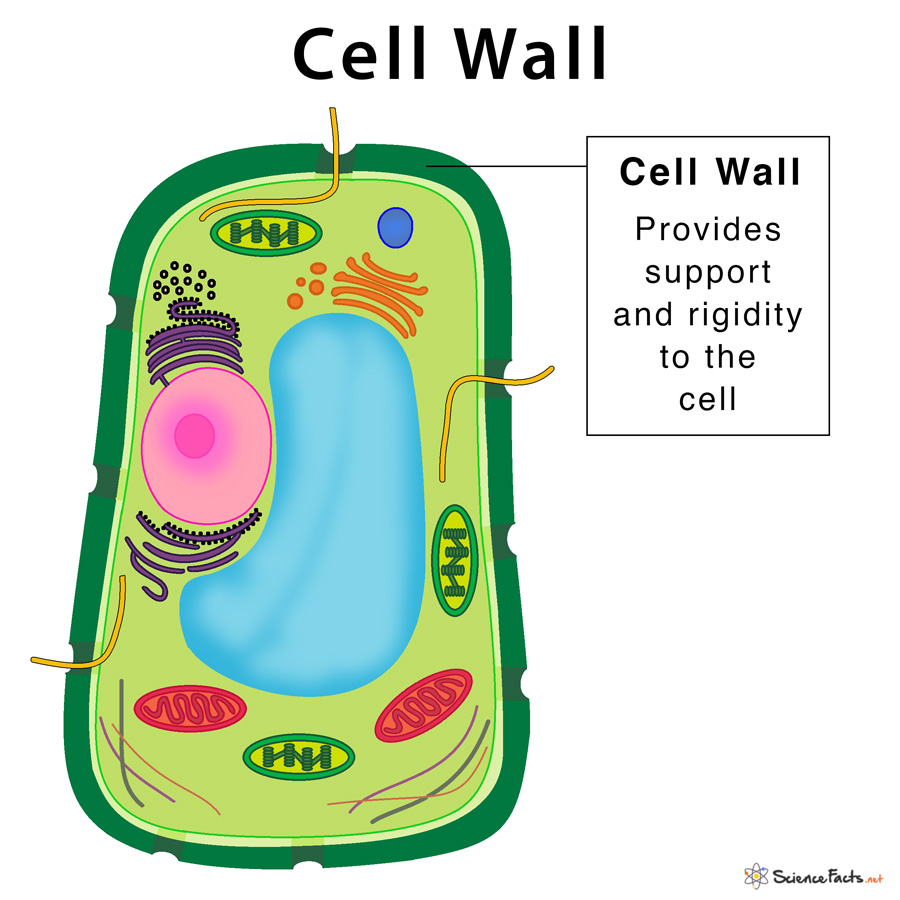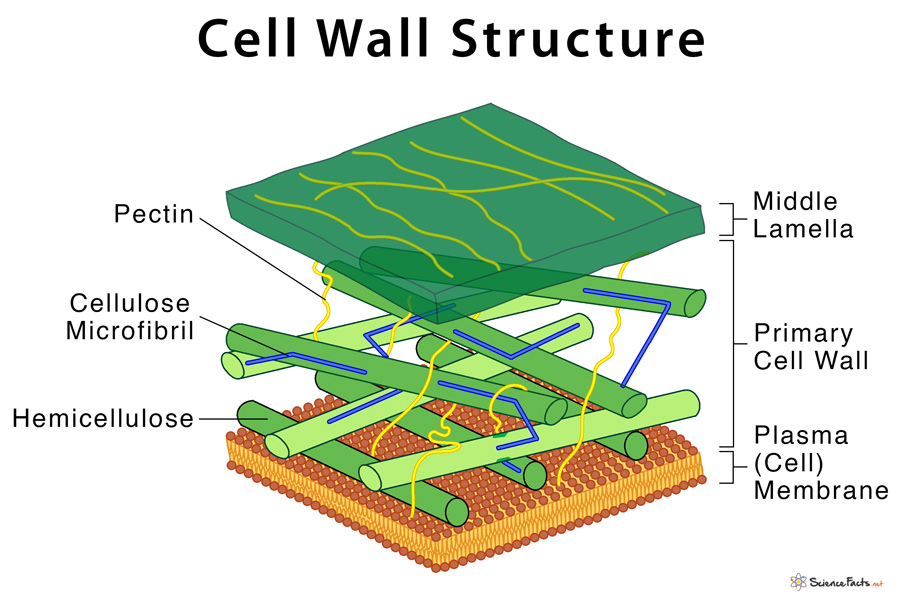Cell Wall: Structure, Composition, and Functions
What is a Cell Wall
The cell wall is a rigid and protective outer covering commonly found in both prokaryotic and eukaryotic organisms such as plants, fungi, algae, bacteria, and archaea, but is absent in all animal cells. It is a non-living structure that varies in color and composition depending on the type of organism, and is freely permeable to natural substances. The cell wall performs many important purposes in a cell, including protection, structure, and support.
The cell wall was discovered by Robert Hooke in 1665, while its name came from the Latin word ‘cella’, meaning a ‘small room’.
Structure and Composition: What is the Cell Wall Made of
Plant Cell Wall
It is multilayered and consists mainly of three distinct components. If a plant cell looks like a water balloon, the cell wall is analogous to a cardboard box that protects the balloon from damage. When viewed from outside, they are arranged as middle lamella, primary cell wall, and secondary cell wall. Although all plant cells have a middle lamella and primary cell wall, they may not have a secondary cell wall.
- Middle Lamella: The outermost layer of the cell wall, made of polysaccharides called pectins that help adjacent cells to bind with one another.
- Primary Cell Wall: Located between the middle lamella and plasma membrane in growing plant cells. It is primarily composed of cellulose microfibrils contained within a gel-like matrix of hemicellulose fibers and pectin polysaccharides. The primary cell wall provides the strength and flexibility to the cell. A minute pore called plasmodesmata creates channels that cross the cell walls and allow direct communication between adjacent cell cytoplasms, thus allowing cell-cell communication.
- Secondary Cell Wall: Develop once the primary cell wall has stopped dividing and growing, it may thicken to form a secondary cell wall that provides additional strength and protection to the cell. The secondary cell wall is formed between the primary cell wall and plasma membrane in some plant cells. In addition to cellulose and hemicellulose, some secondary cell walls contain lignin that increases its hardness and also aids in water conductivity in plant tissues
Fungal Cell Walls
In general, fungi with cell wall have three layers that together increase the rigidity and strength of the cell wall:
- Chitin: The innermost layer of a fungal cell wall, it is fibrous in nature, and made up of polysaccharides.
- Glucans: Found next to the chitin layer, these are glucose polymers that are interlinked with chitin.
- Proteins: The final layer of the cell wall in fungi, it is made of structural proteins called mannans, commonly called mannoproteins that are attached to mannose sugar. The mannoproteins, along with the mannose sugar, also helps in cell signaling.
Cell Walls in Algae
Algae being a widely diverse group, their cell walls also vary in their composition. In algae it consists of polysaccharides, like cellulose or glycoproteins, while others contain both of them. In addition, algal cell walls may have mannans, xylans, alginic acid, and sulfonated polysaccharides. While mannans are proteins that make microfibrils in some green and red algae, xylans are complex polysaccharides that are sometimes found to replace cellulose in algae. Another type of polysaccharide, the alginic acid is often found in brown algae.
Cell Walls in Bacteria
The most commonly studied prokaryotic cell wall found outside the cell membrane; it is primarily made of a unique molecule called peptidoglycan or murein. Peptidoglycan consists of alternating sugars and amino acids arranged in a mesh-like layer that helps to provide shape and protection to the cell. Based on its composition and the ability to retain dyes, the bacterial cell wall is classified into two distinct groups.
Gram-positive bacterial cell wall: Contains thick, multiple layers of peptidoglycan that are arranged stack by stack
Gram-negative bacterial cell wall: Contains a thin layer of peptidoglycan, that is surrounded by an outer layer of lipopolysaccharides (LPS). The LPS protects gram-negative bacteria against certain antibiotics, such as penicillins.
Cell Walls in Archaea
Semi-rigid in nature, it is mostly composed of surface-layer proteins called S-layers, and lack peptidoglycan molecules, with the exception of methanobacteria that have pseudopeptidoglycan in their cell wall. The pseudopeptidoglycan is distinctly different in composition from the peptidoglycan layer found in the prokaryotic bacterial cell wall.
Functions: What Does the Cell Wall Do
Main Functions
- Shape Maintenance: Forms a framework for the cell and prevents it’s over expansion
- Support: Provides mechanical strength and rigidity to the cell
- Protection: Forms a barrier to protect internal cellular components from physical shock and also against viruses and other pathogens that may cause disease
Other Functions
- Storage: Helps to stores carbohydrates in seeds that plants use as food
- Turgidity Maintenance: Prevents water loss through evaporation that helps the cell to remain erect and perform food production through photosynthesis. The turgor pressure also helps a cell to break open or rupture.
- Growth: Turgidity of the cell helps in its elongation and expansion along a direction that helps a plant to grow
- Communication: Helps in establishing communication between cells that allows passing and exchanging signals and other molecules across the cell through diffusion
FAQs
Ans. Although most bacteria have a cell wall, few others such as Mycoplasma group and L-shaped bacteria do not have a cell wall protecting their cell.
Ans. Animal cells do not have a cell wall because they do not need them. Since animals have bones and skeletons that help them to provide shape and also protect them from external physical injuries, they do not need a cell wall.
Ans. Monera, Fungi, and Plantae are the three Kingdoms that are found to have their own cell walls while kingdom Animalia are completely devoid of them.
Ans. Humans being a member of the kingdom Animalia do not have a cell wall.
Ans. The cell wall gives tensile strength and protection to the plant cell against mechanical and osmotic stress. It also allows cells to develop turgor pressure, which is the pressure exerted by the cell contents against their cell wall thus helping plants in their growth and development.
Ans. Since cell wall provides rigidity to the cell and Paramecium needs flexibility in their movement they do not have a cell wall.
-
References
Article was last reviewed on Thursday, July 16, 2020





